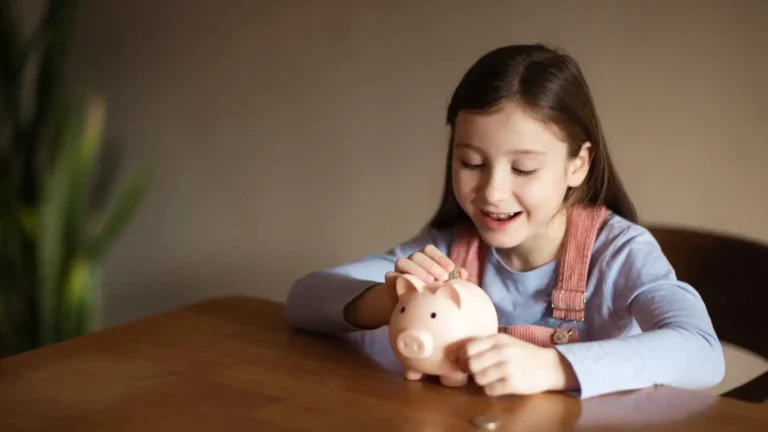Table of Contents
Introduction
Teaching kids about financial responsibility early is essential. It gives them a huge head start in life. They grow up with more confidence when they learn how to manage money from a young age. They also learn smarter habits. With time, they develop a healthier relationship with both spending and saving. Financial Responsibility to Kids Through Allowances is one of the most effective ways to teach them the value of money and decision-making.
One of the easiest and most practical ways to start? Allowances. Whether it’s tied to chores or given on a weekly basis, an allowance helps kids understand the basics. They can learn by earning money and choosing how to spend it. This teaches the value of saving.
With tools like Beem’s Everdraft™, parents can take it a step further. Beem empowers you to grow your emergency fund or future investments effortlessly. High-yield savings, easy tracking, and smart financial tools make it simple. It’s a hands-on way to build smart habits and financial awareness. This comes without the risk.
Why Allowances Are a Powerful Teaching Tool
Allowances aren’t just about giving kids money. But they’re about giving them real-life experience with managing it.
When kids receive an allowance, they start to understand the basics. They understand that money doesn’t just appear, spending means making choices, and saving takes patience. It’s a simple way to teach cause and effect. They earn it, plan it, and use it wisely.
Over time, these lessons develop important life skills. It can involve such responsibilities as self-control and goal-setting. And the best part? They’re learning all of this in a safe environment, with your support. This is before they ever have to manage their own money.
Understanding the Purpose Behind an Allowance
An allowance isn’t just about giving kids money to spend; it’s about teaching them valuable financial skills. But it’s about teaching them how to use money wisely.
It gives them a chance to learn real-life skills. It can include budgeting and saving for something they want. This is even sharing through giving. Instead of just being told what to do, they get to make their own choices. Sometimes they can face their own mistakes.
And that’s the point. This is when kids learn to manage small amounts of money in a safe yet low-pressure way. This way, they build confidence and habits that will last a lifetime.
The Ideal Age to Start Giving Allowances
- Ages 6–8:
Start simple. A small, symbolic allowance helps kids learn. It offers the basics of saving vs. spending. You can use things like jars or piggy banks to keep it visual and hands-on.
- Ages 9–12:
As they grow, add more structure. You can tie allowance to simple responsibilities or help them save toward short-term goals. It can be like a toy or outing.
- Ages 13–18:
Teens are ready for more independence. This is an ideal opportunity to introduce digital banking tools or prepaid cards. This provides them with real-life experience in budgeting. It also helps track their finances.
Your child can develop smart money habits gradually, just as adults transition from cash to digital tools. Tools like Beem’s Everdraft™ can support that journey. It provides teens with a safe way to manage their spending while keeping parents involved when needed.
Allowance Systems That Teach Responsibility
Fixed Weekly Allowance
This is a simple and consistent system. It is where kids get the same amount each week.
- It teaches them how to budget within limits.
- Great for younger kids. It is ideal for those who are just starting to manage their finances.
Chore-Based Allowance
Kids earn money by completing household tasks.
- It connects effort to reward.
- Helps them understand the value of money, which comes from work and responsibility.
Goal-Based Allowance
Allowances are tied to specific savings goals.
- It can encourage planning and patience.
Hybrid Approach
A mix of fixed and chore- or goal-based allowances.
- Offers consistency. This is while still promoting effort and responsibility.
- Reflects real-life earning patterns. It is like a steady salary plus bonuses or goals.
Setting the Right Rules and Expectations
It’s essential to establish clear and straightforward ground rules from the outset. This is to get the most out of giving an allowance.
First, ensure your child understands the reason. This isn’t just “free money.” It’s a tool to help them learn how to make informed financial decisions.
You must set clear boundaries together. These guidelines help kids build structure. This allows them to have still some freedom to make their own decisions.
Most importantly, you must keep the conversation going. These small reflections are where the real lessons stick.
Teaching Saving, Spending, and Sharing
Saving
It teaches kids patience. It also helps them in goal-setting. It shows that waiting for something one truly wants is worthwhile.
Spending
This gives them the chance to make their own choices. Sometimes, they can learn from mistakes. It helps build confidence. It also involves decision-making skills.
Sharing
It helps them see that money isn’t just for themselves. It teaches empathy. This also demonstrates that money can be used for good.
This simple system keeps things balanced and gives money real meaning. This is even in small amounts.
How to Use Allowances to Teach Budgeting
An allowance is a great way to introduce kids to the basics of budgeting. This is without overwhelming them.
Start by encouraging them to track their spending. This can be recorded in a simple notebook, on a whiteboard, or using a kid-friendly app. Visual tools, such as jars or envelopes, work especially well for younger kids. They can see where their money is going.
Break their allowance into categories. It can be as simple as saving, spending, and sharing. This will help them plan small budgets for things they care about.
It’s the same idea behind tools like Beem’s Everdraft™. You spend smartly, stay in control, and avoid overextending. Kids may not have bills yet. But learning to manage limited funds thoughtfully. It gives them a foundation for financial confidence later on.
Also Read: How to Raise Financially Responsible Kids Without Overwhelming Them
Using Technology to Reinforce Financial Learning
Today’s kids are growing up in a digital world. This is why we should not rely on technology to help them develop smart money habits.
Start by introducing kid-friendly banking apps or prepaid cards. This comes with built-in parental controls. These tools enable kids to practice managing money in a safe and supervised environment. It is while giving them a taste of real-world responsibility.
Use this opportunity to discuss safe digital spending. This is how to track online purchases, and the basics of budgeting with just a few taps.
You can also help them understand tools like Beem’s Everdraft™ as early examples of healthy money management. Teach them that borrowing isn’t bad. This is as long as it’s done thoughtfully. This is done with a plan to repay and track what’s coming in and going out.
You’re building their financial confidence in a digital future by combining hands-on experience with real-world tools.
Common Mistakes Parents Make with Allowances
Giving your kids an allowance is a great idea. But a few missteps can get in the way of the lesson:
- If you are using it as a bribe or a punishment. Instead, you must use it as a learning tool.
- Being inconsistent with amounts or timing. It makes planning or budgeting harder.
- Bailing them out too often. This is instead of letting small mistakes teach big lessons.
- Forgetting to talk about money. It helps to hand it over without explaining the why.
How to Talk About Money Without Pressure
Talking to kids about money doesn’t have to be a serious or stressful experience. You must keep it casual, positive, and age-appropriate.
Use real-life moments to spark natural conversations. It can be like comparing prices at the store or planning a family outing. These everyday examples help kids connect the dots without feeling overwhelmed.
And most importantly, show them that being smart with money isn’t about saying “no” all the time. But it’s about making choices that give you more freedom in the long run.
The Role of Parental Modeling
Kids learn about money mostly by watching their parents. It is not just by listening.
You must show them how you save for goals, track your spending, and celebrate smart money moves.
With the Beem app, boost your savings with up to 5% APY, 11 times higher than the national average.* Keep your money safe and growing in an FDIC-insured account.
Also Read: What Is the Best Age to Teach Kids About Saving and Budgeting?
When to Adjust or Stop Allowances
As kids grow, their money skills should grow too. Start easing up on supervision. This is when they demonstrate their ability to manage responsibly.
For teens, consider switching from cash to a digital wallet or debit card. But it gives them more independence while still allowing for guidance.
Once they start earning, they have their own money. It might be time to phase out the allowance. They will shift the focus to independent budgeting and real-world planning.
The goal is to support their journey from learning to full financial confidence.
Conclusion
Allowances aren’t just about giving kids money. But they’re about teaching real-life skills. It includes responsibility, decision-making, and independence.
With steady guidance and tools like Beem’s Everdraft™, parents can help kids build healthy money habits. This grows with them.
The goal? Raising kids who see money not as a reward or something to fear. But to use it as a tool to make smart, thoughtful choices throughout life.
FAQs on Financial Responsibility to Kids Through Allowances
What’s the best age to start giving kids an allowance?
Around ages 6–8 is a good start, using small, symbolic amounts that teach saving and decision-making.
Should allowances be tied to chores?
Both models work—tie it to effort for accountability or keep it separate to promote budgeting practice. The key is consistency.
How can I ensure my child doesn’t overspend?
Encourage setting spending limits and maintaining a simple budget. Use visual trackers or digital apps to monitor flow.
How does Beem’s Everdraft™ connect to teaching kids about responsibility?
Everdraft™ demonstrates how short-term funds can be utilized wisely and repaid on time—mirroring the lessons kids learn from budgeting allowances. It helps families model responsible borrowing and spending behavior.
How do I move from cash allowances to digital money management?
Start with supervised prepaid cards or kid-friendly financial apps. Discuss digital safety and spending awareness before granting full autonomy.















































